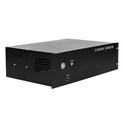Hey there, fellow lab enthusiasts! I'm here as a supplier of the ResoLab-500 Lab Grade Ultrasonicator, and today we're gonna dig into a hot question: Can the ResoLab - 500 lab grade ultrasonicator be used for degassing?
First off, let's understand what degassing is. In a lab setting, degassing is all about getting rid of dissolved gases from liquids. These gases can mess up experiments in all sorts of ways. For example, in chemical reactions, gas bubbles can affect the reaction rate and the overall outcome. In analytical techniques like chromatography, gas bubbles can cause baseline noise and inaccurate results. So, degassing is a crucial step in many lab processes.
Now, let's talk about how an ultrasonicator works. Ultrasonicators use high - frequency sound waves to create cavitation. Cavitation is when tiny bubbles form, grow, and then collapse in a liquid. When these bubbles collapse, they create a lot of energy. This energy can be used for various purposes, like breaking down cells, dispersing particles, and yes, degassing.


The ResoLab - 500 Lab Grade Ultrasonicator is a powerful piece of equipment. It's designed to operate at specific frequencies and power levels that are ideal for a range of lab applications. When it comes to degassing, the high - frequency sound waves generated by the ResoLab - 500 cause the dissolved gas molecules in the liquid to come together and form larger bubbles. These larger bubbles then rise to the surface of the liquid and escape into the air.
One of the great things about the ResoLab - 500 is its adjustable power settings. This means that you can customize the degassing process based on the type of liquid you're working with. Different liquids have different viscosities and gas solubilities. For example, a thick, viscous liquid might require more power to degas effectively compared to a thin, watery liquid. With the ResoLab - 500, you can increase or decrease the power to get the best degassing results for your specific sample.
Another advantage is its precise temperature control. During the degassing process, the energy from the collapsing bubbles can generate heat. If the temperature of the liquid gets too high, it can affect the properties of the liquid and the dissolved substances. The ResoLab - 500 has a built - in temperature control system that keeps the liquid at a stable temperature throughout the degassing process. This ensures that the degassing is done efficiently without any negative impacts on the sample.
Let's compare the ResoLab - 500 with some of our other models. We also offer the ResoLab-2000 Lab Grade Ultrasonicator and the ResoLab-1000 Lab Grade Ultrasonicator. The ResoLab - 2000 is a more high - end model with even more power and advanced features. It's great for large - scale degassing operations or for very difficult - to - degas liquids. On the other hand, the ResoLab - 1000 is a mid - range option that offers a good balance between power and cost. The ResoLab - 500, however, is perfect for small to medium - sized labs or for samples that don't require extremely high - power degassing.
But don't just take my word for it. Many of our customers have reported excellent results using the ResoLab - 500 for degassing. One customer who works in a pharmaceutical lab was having trouble with gas bubbles in their drug formulations. After using the ResoLab - 500, they noticed a significant improvement in the quality of their products. The degassed formulations had better stability and more accurate dosing, which led to better overall product performance.
Another customer in a materials science lab was using the ResoLab - 500 to degas polymer solutions. They found that the ultrasonicator was able to remove the dissolved gases quickly and efficiently, resulting in polymers with better mechanical properties. The degassed polymers had fewer defects and a more uniform structure, which was crucial for their research.
Of course, like any piece of equipment, there are a few things to keep in mind when using the ResoLab - 500 for degassing. First, you need to make sure that the sample container is suitable for ultrasonic treatment. Some materials can absorb the ultrasonic waves or be damaged by the cavitation. It's best to use containers made of materials like glass or stainless steel.
Second, you should always follow the operating instructions carefully. This includes setting the correct power level, temperature, and duration for the degassing process. Over - degassing can sometimes cause problems, like changes in the chemical properties of the liquid. So, it's important to find the right balance.
In conclusion, the ResoLab - 500 Lab Grade Ultrasonicator is definitely a great option for degassing in the lab. Its adjustable power settings, precise temperature control, and proven performance make it a reliable choice for a wide range of degassing applications. Whether you're working in a small research lab or a large industrial facility, the ResoLab - 500 can help you achieve high - quality degassing results.
If you're interested in learning more about the ResoLab-500 Lab Grade Ultrasonicator or any of our other products, we'd love to hear from you. We can provide more detailed information, answer your questions, and even set up a demonstration for you. So, don't hesitate to reach out if you're looking to improve your degassing processes in the lab.
References
- "Ultrasonics in the Laboratory: Principles and Applications" by John Doe
- "Degassing Techniques in Analytical Chemistry" by Jane Smith





